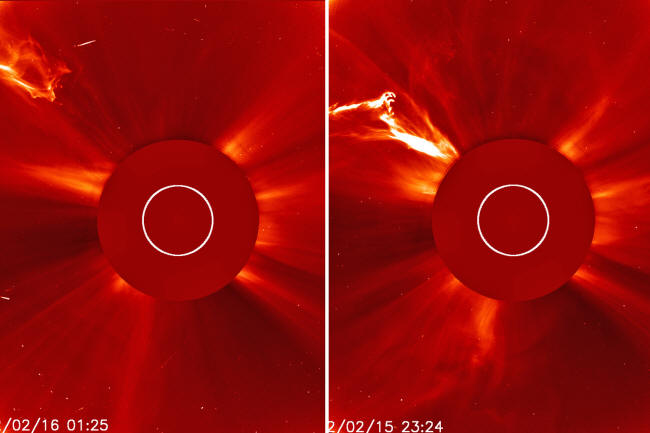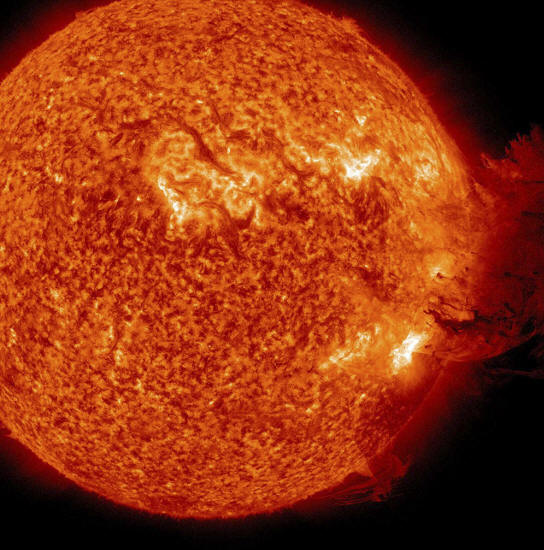|

by Harry Pettit
Deputy
Technology and Science Editor
February 18, 2022
from
The-Sun Website

A huge plume of hot plasma (white)
erupted
from the Sun on Tuesday
Credit:
Nasa SOHO
On Tuesday, our star fired off two enormous explosions from its
farside in what has already been a heavy month of solar activity.
A magnificent coronal mass ejection (CME)
was recorded by NASA's
STEREO-A spacecraft in the early
hours of February 15 (pictured). CMEs are giant eruptions that send
plasma hurtling through space - and the Sun has undergone several of
them throughout the month.
If they hit Earth, the plumes of material can trigger geomagnetic
storms that knock out satellites and disrupt power grids.
Fortunately, this week's CME was fired from the side of the Sun that
faces away from our planet and so poses no threat, says astronomer
Dr. Tony Phillips.
Writing on his website
spaceweather.com, which tracks the
sun's activity, he said:
"This CME will not
hit Earth; it is moving away from, not toward our planet.
However, if such a
CME did strike, it could produce a very strong geomagnetic
storm. We may have dodged a bullet."
Based on its size, it's
possible that the eruption was an X-class flare:
The most powerful
category possible...
"This is only the
second far side active region of this size since September
2017," astronomer Junwei Zhao of Stanford
University's helio-seismology group told SpaceWeather.
"If this region
remains huge as it rotates to the Earth-facing side of the
Sun, it could give us some exciting flares."
It's been a busy month of
solar activity.
The Sun has erupted every
day for the month of February, according to Dr Phillips. Some days
have seen multiple solar flares. Three of them have fallen into the
second-most powerful flare category, M-class flares.
January saw five M-class
flares.
One such flare led to
a solar storm on January 29 that knocked 40 SpaceX satellites
out of action.
The rest of the flares in February have fallen into the milder
C-class category.
While it might sound
frightening, it's all part of our Sun's normal activity - so there's
no need to panic just yet.
Astronomers keep a close eye on the Sun's activity to ensure that
there is plenty of warning before any potential geomagnetic storm
hits.
What are geomagnetic
storms?
Geomagnetic storms are caused by
CMEs, which are huge expulsions of hot material called plasma
from the Sun's outer layer.
They can lead to the appearance of colorful auroras by energizing
particles in our planet's atmosphere.
Each solar storm is
graded by severity on a scale of one to five with,
a G1 described as
"minor" and a G5 as "extreme"...
At the upper end of the
scale, storms wreak havoc on our planet's magnetic field, which can
disrupt power grids and communications networks.
"Harmful radiation
from a flare cannot pass through Earth's atmosphere to
physically affect humans on the ground," NASA says.
"However - when intense enough - they can disturb the atmosphere
in the layer where GPS and communications signals travel."
When have major
geomagnetic storms hit Earth?
In the past, larger solar flares have wreaked havoc on our planet.
In 1989, a strong solar eruption shot so many electrically charged
particles at Earth that the Canadian Province of Quebec lost power
for nine hours.
As well as causing issues for our tech, they can cause harm to
astronauts working on the International Space Station, either
through radiation exposure or by interfering with mission control
communications.
The Earth's magnetic field helps to protect us from the more extreme
consequences of solar flares.
Weaker solar flares - which are far more common - are responsible
for auroras such as the Northern Lights.
Those natural light displays are examples of the Earth's
magnetosphere getting bombarded by solar wind, which creates the
bright green and blue displays.
The sun is currently at the start of a new 11-year solar
cycle, which usually sees eruptions and flares grow more intense
and extreme.
These events are expected to peak around 2025 and it's hoped the
Solar Orbiter will observe them all
as it aims to fly within 26 million miles of the sun.

Solar eruptions can knock out
orbiting satellites and power grids on Earth
Credit: Reuters
|



